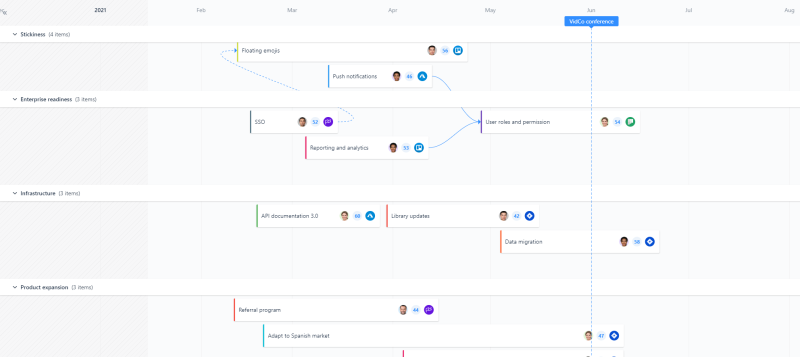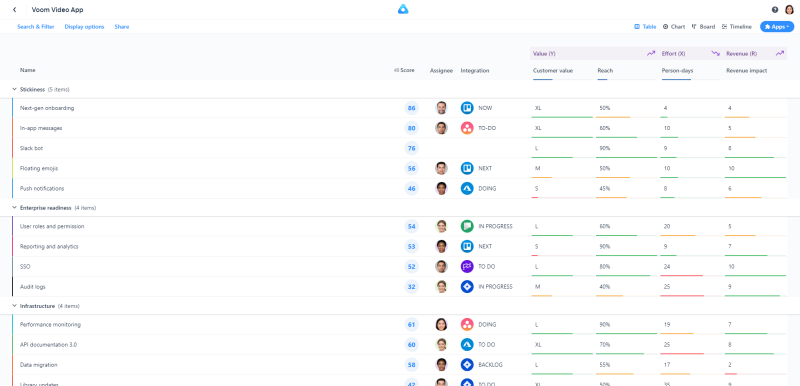A Guide for Creating Your First Product Roadmap - What To Include and What To Avoid

How to create your first roadmap
You have got your very first version of your brilliant new product out.
It is an MVP to prove that the product idea has legs.
But now what?
There are a million ideas, many of them sounding good.
What will you decide to build? And why?
And how can you communicate your intentions to the wider business?
Get clarity on what your product actually is
This may sound silly. To you, it is crystal clear what your product is.
But you may be surprised.
If you ask five people around the company to describe in one sentence what exact problem your product is solving, you might not get the same answers.

Without absolute clarity of the direction the product should be going in, there is no way to create a good roadmap.
So before you set out to create your roadmap, you need a clear and shared product vision and strategy.
Everybody needs to know what end state you are trying to achieve (the vision) and roughly how you plan to get there (the strategy).
We will cover vision and strategy in a separate article.
But now on to the actual roadmap!
The many (mis-) uses of a roadmap
A roadmap can mean many things to many people, for better or worse. Some possible uses are

An overview of how to execute against your product strategy.
A prioritization tool to collaborate with your stakeholders.
A list for the management team showing what your team is planning to work on.
A list of features for your sales team to sell.
An overview of dates when features will be delivered.
Are you feeling uncomfortable yet? You should!
A roadmap is not a project plan. It is not a list of features with dates when they will be delivered.
It is also not a bulleted list for your sales team to sell to customers.
So what is a good roadmap then?
A good roadmap is a statement of intent on how you are going to deliver your product strategy.
A list of objectives
In most cases, your basic structure of the roadmap will be a prioritized list. This list should consist of a list of objectives or outcomes to achieve rather than a list of features.
As we have explained in our article on empowered teams, a product team must focus on outcomes that are important to the business rather than delivering on a list of (unproven) features.
As your insight into your customers’ behaviors and needs evolves, it will give you the knowledge on how to address the objectives prioritized at the time. Ideally, you will be able to use discovery methods to identify what works for your customers. Only at that point do you decide on actual features to build.
This inevitably means that the further out in time an item in your roadmap is, the more high level it becomes.
How long into the future your roadmap should stretch can vary and really depends on how long the horizon for your strategy is. At an early stage of your product, you may not fully know yet, where you want to be in three years. A year’s worth of objectives is a sensible first stab.
Avoiding dates
It is very important that the roadmap can flexibly be adjusted as insight and priorities change over time.
To achieve this, a roadmap should not have fixed dates that can be read as deadlines.
As a product team gets more insight on what is important and what works, dates will inevitably shift. Items will be dropped, and other items added instead. "Missing deadlines" is unnecessary friction in this scenario. If everybody is assured that the team focuses on the most important items at any given time, there should not be any discussion of "deadlines."

One way to avoid dates, for example, is to use three buckets labeled Now / Next / Later.
This shows the priority of each item and is flexible at the same time. If you want to be more specific, you can break the items down into months in the near term and quarters for the longer term.
Highlight tradeoffs
A prioritized list without dates also makes it easier to discuss product priorities with your stakeholders without the distraction of the calendar.
In a prioritized list, any stakeholder can see the tradeoffs of bringing in an item at the top. The discussion of what is more important and what needs to give way without looking at dates allows everybody to focus on the strategic importance of an objective rather than on quarterly revenue, closing a deal, or a PR campaign, for example.

These things may all be important at certain times. That being said, if your roadmap is exclusively driven by such external and short-term considerations, your product will be pulled in many different directions, and you will likely not progress toward a coherent strategy.
Finding your roadmap items
Now that you know what a good roadmap may look like, how do you decide what goes in it?
You will likely have a long list of ideas that have come to you from various teams, customers, competitor reviews, etc.
Now take a deep breath and don’t be overwhelmed.
Use your product strategy and vision to think about what objectives your product needs to achieve to fulfill your strategy.
Thinking about your strategy leads you to "themes" or "epics" for your roadmap rather than features.
As an example, for an eCommerce product, some high-level themes may be
Getting more customers to your site
Engaging them with your products
Getting them to buy your products
Encourage them to come back to buy more
Recommend your products to their friends
Each one of these themes can be broken down even more before becoming a list of features. For example, "engaging customers with your products" can be achieved through
Improving product presentation
Improving successful product searches
Streamlining flow to view a product
etc.
Try and include items like these on your roadmap instead of actual features. This gives you the flexibility to discover the right features to build at the right time. Your long list of ideas will come in handy for inspiration at that point.
Building in a revision loop
To be continuously useful, a roadmap needs to be a living, breathing document that can be changed easily as new insight and priorities emerge. This will happen often and should be encouraged rather than avoided.
With airfocus, all stakeholders have complete transparency of your roadmap at any time.
The collaborative prioritization features allow to easily assess new emerging items or reassess existing ones.
The roadmap automatically adjusts to your new assessment to reflect the new priorities.
Creating your roadmap with airfocus
Collaboration and transparency are key.
Your stakeholders and the product team need to collaborate on determining the priorities based on your business and product strategy.
They also need to be confident that the team is working on the highest priorities at any given time.
With airfocus, you can easily collaborate on coming up with the themes to priorities.
So how do you determine the actual priorities?
There are several models to help you assess each theme based on expected business value versus effort involved.
One frequently used prioritization framework is RICE, but you can use any model you like in airfocus. You can also use tools like Priority Poker to get your team involved in the prioritization process.
You can then see the most impactful initiatives in a great visual presentation to identify what to focus on now versus later.
The visualization provides a good view of the tradeoffs too.
Conclusion
Creating the first roadmap can be a daunting prospect, but if you follow these steps, it will become easy:
Understand your product vision and strategy
Identify product themes to fulfill your strategy
Collaborate to prioritize your themes with stakeholders
Constantly review and adjust your roadmap as new insight emerges
Happy roadmapping!

Kerstin Exner

Read also




Build great roadmaps

Experience the new way of doing product management



